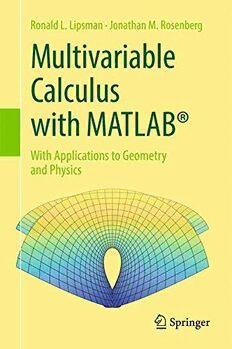
Multivariable Calculus with MATLAB®: With Applications to Geometry and Physics PDF
Preview Multivariable Calculus with MATLAB®: With Applications to Geometry and Physics
® Multivariable Calculus with MATLAB · Ronald L. Lipsman Jonathan M. Rosenberg Multivariable Calculus ® with MATLAB With Applications to Geometry and Physics RonaldL.Lipsman JonathanM.Rosenberg DepartmentofMathematics DepartmentofMathematics UniversityofMaryland UniversityofMaryland CollegePark,MD,USA CollegePark,MD,USA ISBN978-3-319-65069-2 ISBN978-3-319-65070-8(eBook) DOI10.1007/978-3-319-65070-8 LibraryofCongressControlNumber:2017949120 ©SpringerInternationalPublishingAG2017 Thisworkissubjecttocopyright.AllrightsarereservedbythePublisher,whetherthewholeorpartof thematerialisconcerned,specificallytherightsoftranslation,reprinting,reuseofillustrations,recitation, broadcasting,reproductiononmicrofilmsorinanyotherphysicalway,andtransmissionorinformation storageandretrieval,electronicadaptation,computersoftware,orbysimilarordissimilarmethodology nowknownorhereafterdeveloped. Theuseofgeneraldescriptivenames,registerednames,trademarks,servicemarks,etc.inthispublication doesnotimply,evenintheabsenceofaspecificstatement,thatsuchnamesareexemptfromtherelevant protectivelawsandregulationsandthereforefreeforgeneraluse. Thepublisher,theauthorsandtheeditorsaresafetoassumethattheadviceandinformationinthisbook arebelievedtobetrueandaccurateatthedateofpublication.Neitherthepublishernortheauthorsor theeditorsgiveawarranty,expressorimplied,withrespecttothematerialcontainedhereinorforany errorsoromissionsthatmayhavebeenmade.Thepublisherremainsneutralwithregardtojurisdictional claimsinpublishedmapsandinstitutionalaffiliations. Printedonacid-freepaper ThisSpringerimprintispublishedbySpringerNature TheregisteredcompanyisSpringerInternationalPublishingAG Theregisteredcompanyaddressis:Gewerbestrasse11,6330Cham,Switzerland Preface 4 3 z2 1 0 2 1 1 2 0 0 -1 y -1 -2 x The preface of a book gives the authors their best chance to answer an extremely importantquestion:Whatmakesthisbookspecial? ThisbookisareworkingandupdatingforMATLABofourpreviousbook(joint ® with Kevin R. Coombes) Multivariable Calculus with Mathematica , Springer,1998.Itrepresentsourattempttoenrichandenliventheteachingofmul- tivariable calculus and mathematical methods courses for scientistsand engineers. Mostbooksinthesesubjectsarenotsubstantiallydifferentfromthoseoffiftyyears ago. (Well, they may include fancier graphics and omit several topics, but those are minor changes.) This book is different. We do touch on most of the classical topics; however, we have made a particular effort to illustrate each point with a significant example. More importantly, we have tried to bring fundamental physi- calapplications—Kepler’slaws,electromagnetism,fluidflow,energyestimation— back to a prominent position in the subject. From one perspective, the subject of multivariable calculus only existsbecause itcan beapplied toimportantproblems inscience. Inaddition,wehaveincludedadiscussionofthegeometricinvariantsofcurves andsurfaces,providing,ineffect,abriefintroductiontodifferentialgeometry.This materialprovidesanaturalextensiontothetraditionalsyllabus. We believe that we have succeeded in resurrecting material that used to be in the course while introducing new material. A major reason for that success is that weusethecomputationalpowerofthemathematicalsoftwaresystemMATLABto carry a large share of the load. MATLAB is tightly integrated into every portion of this book. We use its graphical capabilities to draw pictures of curves and sur- faces;weuse itssymbolical capabilities tocompute curvature and torsion;we use itsnumericalcapabilitiestotackleproblemsthatarewellbeyondthetypicalmun- daneexamplesoftextbooksthattreatthesubjectwithoutusingacomputer.Finally, and this is something not done in any other books at this level, we give a serious yet elementary explanation of how various numerical algorithms work, and what their advantages and disadvantages are. Again, this is something that could not be accomplishedwithoutasoftwarepackagesuchasMATLAB. v vi Preface AsanadditionalbenefitfromintroducingMATLAB,weareabletoimprovestu- dents’understandingofimportantelementsofthetraditionalsyllabus.Ourstudents arebetterabletovisualizeregionsintheplaneandinspace.Theydevelopabetter feelforthegeometricmeaningofthegradient;forthemethodofsteepestdescent; fortheorthogonalityoflevelcurvesandgradientflows.Becausetheyhavetoolsfor visualizingcrosssectionsofsolids,theyarebetterabletofindthelimitsofintegra- tioninmultipleintegrals. Tosummarize,wethinkthisbookisspecialbecause,byusingit: (cid:129) studentsobtainabetterunderstandingofthetraditionalmaterial; (cid:129) studentsseethedeepconnectionsbetweenmathematicsandscience; (cid:129) studentslearnmoreabouttheintrinsicgeometryofcurvesandsurfaces; (cid:129) studentsacquireskillusingMATLAB,apowerfulpieceofmodernmathematical software; (cid:129) instructorscanchoosefromamoreexcitingvarietyofproblemsthaninstandard textbooks;and (cid:129) both students and instructors are exposed to a more holistic approach to the subject—onethatembracesnotonlyalgebraic/calculus-basedsolutionstoprob- lems, but also numerical, graphical/geometric and qualitative approaches to the subjectanditsproblems. Conventions Throughout the book, MATLAB commands, such as solve, are printed in type- writer boldface. Theorems and general principles, such as: derivativesmeasure change, are printed in a slanted font. When new terms, such as torsion, are intro- duced,theyareprintedinanitalicfont.FilenamesandURLs(webaddresses)are printedintypewriter font.Everythingelseisprintedinastandardfont. At the start of each chapter, below the title, is a small illustration. Each is a graphic generated by a MATLAB command. Most are taken from the MATLAB solutiontooneoftheproblemsintheaccompanyingproblemset.Afewaretaken fromthechapteritself.Finally,inthisPreface,thegraphicrepresentsamoreeclectic choice.Weleaveittotheindustriousreadertoidentifythesourceofthesegraphics, aswellastoreproducethefigure. Acknowledgments We above all want to thank our former collaborators for their contributions to this project.KevinCoombes(nowattheDepartmentofBiomedicalInformaticsatOhio ® State University) was a co-author of Multivariable Calculus with Mathematica and kindly agreed to let us adapt that book for MATLAB. Brian Hunt was a co-authorofAGuidetoMATLABandtaughtusmanyusefulMATLABtricksand Preface vii tips.PaulGreenhelpeddevelopMATLABexercisesformultivariablecalculusthat eventuallyworkedtheirwayintothisbook. JonathanRosenbergthankstheNationalScienceFoundationforitssupportunder grantDMS-1607162.Anyopinions,findings,andconclusionsorrecommendations expressedinthismaterialarethoseoftheauthorsanddonotnecessarilyreflectthe viewsoftheNationalScienceFoundation. CollegePark,MD,USA RonaldL.Lipsman October1,2017 JonathanM.Rosenberg Contents Preface........................................................... v 1 Introduction................................................... 1 1.1 BenefitsofMathematicalSoftware ............................ 2 1.2 What’sinThisBook ........................................ 3 1.2.1 ChapterDescriptions ................................. 3 1.3 What’sNotinThisBook .................................... 5 1.4 HowtoUseThisBook ...................................... 6 1.5 TheMATLABInterface ..................................... 7 1.5.1 AWordonTerminology .............................. 8 1.6 SoftwareVersions .......................................... 8 ProblemSetA.ReviewofOne-VariableCalculus .................... 9 GlossaryofMATLABCommands ................................. 12 OptionstoMATLABCommands .................................. 13 References..................................................... 13 2 VectorsandGraphics........................................... 15 2.1 Vectors ................................................... 15 2.1.1 ApplicationsofVectors ............................... 17 2.2 ParametricCurves .......................................... 19 2.3 GraphingSurfaces.......................................... 23 2.4 ParametricSurfaces......................................... 25 ProblemSetB.VectorsandGraphics............................... 27 GlossaryofMATLABCommands ................................. 31 OptionstoMATLABCommands .................................. 31 3 GeometryofCurves ............................................ 33 3.1 ParametricCurves .......................................... 33 3.2 GeometricInvariants........................................ 36 3.2.1 Arclength........................................... 36 3.2.2 TheFrenetFrame .................................... 37 ix x Contents 3.2.3 CurvatureandTorsion ................................ 39 3.3 DifferentialGeometryofCurves .............................. 42 3.3.1 TheOsculatingCircle ................................ 42 3.3.2 PlaneCurves........................................ 43 3.3.3 SphericalCurves..................................... 44 3.3.4 HelicalCurves ...................................... 44 3.3.5 Congruence......................................... 45 3.3.6 TwoMoreExamples ................................. 47 ProblemSetC.Curves ........................................... 51 GlossaryofMATLABCommands ................................. 59 4 Kinematics .................................................... 61 4.1 Newton’sLawsofMotion ................................... 61 4.2 Kepler’sLawsofPlanetaryMotion............................ 64 4.3 StudyingEquationsofMotionwithMATLAB .................. 65 ProblemSetD.Kinematics ....................................... 67 GlossaryofMATLABCommands ................................. 72 Reference...................................................... 73 5 DirectionalDerivatives.......................................... 75 5.1 VisualizingFunctionsofTwoVariables ........................ 75 5.1.1 Three-DimensionalGraphs ............................ 76 5.1.2 GraphingLevelCurves ............................... 77 5.2 TheGradientofaFunctionofTwoVariables.................... 80 5.2.1 PartialDerivativesandtheGradient..................... 80 5.2.2 DirectionalDerivatives ............................... 82 5.3 FunctionsofThreeorMoreVariables.......................... 85 ProblemSetE.DirectionalDerivatives ............................. 89 GlossaryofMATLABCommandsandOptions ...................... 94 OptionstoMATLABCommands .................................. 94 6 GeometryofSurfaces........................................... 95 6.1 TheConceptofaSurface .................................... 95 6.1.1 BasicExamples...................................... 96 6.2 TheImplicitFunctionTheorem............................... 102 6.3 GeometricInvariants........................................ 105 6.4 CurvatureCalculationswithMATLAB ........................ 112 ProblemSetF.Surfaces .......................................... 115 GlossaryofMATLABCommandsandOptions ...................... 121 OptionstoMATLABCommands .................................. 121 References..................................................... 121 Contents xi 7 OptimizationinSeveralVariables................................ 123 7.1 TheOne-VariableCase...................................... 123 7.1.1 AnalyticMethods.................................... 123 7.1.2 NumericalMethods .................................. 124 7.1.3 Newton’sMethod .................................... 125 7.2 FunctionsofTwoVariables .................................. 127 7.2.1 SecondDerivativeTest................................ 128 7.2.2 SteepestDescent..................................... 130 7.2.3 MultivariableNewton’sMethod ....................... 133 7.3 ThreeorMoreVariables..................................... 134 7.4 ConstrainedOptimizationandLagrangeMultipliers.............. 136 ProblemSetG.Optimization...................................... 139 GlossaryofMATLABCommands ................................. 146 8 MultipleIntegrals.............................................. 147 8.1 AutomationandIntegration .................................. 147 8.1.1 RegionsinthePlane.................................. 148 8.1.2 ViewingSimpleRegions .............................. 151 8.1.3 PolarRegions ....................................... 152 8.2 AlgorithmsforNumericalIntegration.......................... 156 8.2.1 Algorithms for Numerical Integration in a Single Variable ............................................ 156 8.2.2 AlgorithmsforNumericalMultipleIntegration ........... 157 8.3 ViewingSolidRegions ...................................... 160 8.4 AMoreComplicatedExample ............................... 165 8.5 CylindricalCoordinates ..................................... 169 8.6 MoreGeneralChangesofCoordinates......................... 170 ProblemSetH.MultipleIntegrals.................................. 173 GlossaryofMATLABCommands ................................. 183 9 MultidimensionalCalculus...................................... 185 9.1 TheFundamentalTheoremofLineIntegrals.................... 186 9.2 Green’sTheorem........................................... 190 9.3 Stokes’Theorem ........................................... 192 9.4 TheDivergenceTheorem .................................... 194 9.5 VectorCalculusandPhysics ................................. 196 ProblemSetI.MultivariableCalculus .............................. 199 GlossaryofMATLABCommands ................................. 202 OptionstoMATLABCommands .................................. 203 References..................................................... 203
